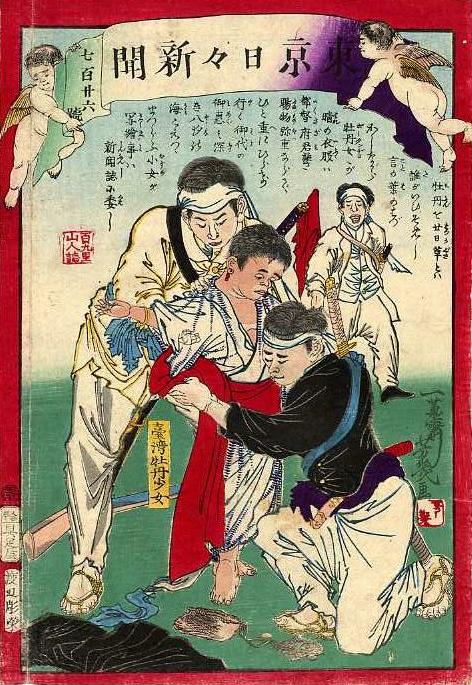Tokyo nichinichi shinbun Story translationSomeone began calling botan [peonies] twenty-day grass (hatsukagusa). The Bootang girl (bootan jo) is shy (hadzukashi) about speaking. Her fine clothing is a warm gift from the governor-general (ikusagimi). It is not a multilayered [kimono] (yae) but a single layer. This is a drawing (utsushie) of the girl (musume) who humbly crossed the multiwaved seas (yashio no umi), deep with the August Mercy (mimegumi) of the August Reign (miyo) [of Emperor Meiji], which opens out (hirakeyuku) in a single layer (hitoe). The matter is detailed in the newspaper (shinbunshi). By Hyakkuri Sanjin [Translated by William Wetherall] Raw savagesAn article in Tonichi No. 726 (26 June 1874), on which this print is supposed to be based, describes the girl and her tribe like this.
Yoshiiku's drawing also reflects a description in Tonichi No. 729 (29 June 1874).
The girl was brought to Japan, shown what a wonderful place it was, and returned to Taiwan. Her treatment and visit occasioned a number of articles in the Tonichi and other papers. Mostly they reported that she didn't seem very happy. Apparently she didn't smile a lot when she returned to Taiwan, either. A village chief and daughter of a relative came to meet her. Ono suggests she may have been in shock, wondering where her parents were. (Ono 1972:152). Takahashi is a bit more blunt about the cause for her lack of enthusiasm toward her hosts, even though they may have thought they were being kind. "It's only natural," he said. "Children aren't so dirty that they flatter people who have killed their parents." (Takahashi 1992a:156). (WW) Commentary (Andon 80)The cartouche reads "Taiwan Botan maiden". The story is full of the sort of euphonic and semantic wordplay that characterises such narratives. The most notable here are "hatsukagusa" / "koto no ha no hadzukashi" and "yae" / "hitoe" / "yashio". Both the flower and the place are written with kanji which are read mŭdān and mean peony in Chinese today. The writer has shown different pronunciations -- "botan" (hiragana) for the flower, "bootan" (katakana) for the place. The "n" in "bootan" is pronounced "ng", and in fact on some maps the place was written "Bootang". Botan village (J. Botansha, C. Mŭdānshè), on the southernmost peninsula of Taiwan, was the object of a Japanese expedition in the spring of 1874 to punish villagers who had massacred over fifty shipwrecked Ryūkyūan (Okinawan) fisherman in 1871. The expedition was led by Saigō Takamori's younger brother, Saigō Tsugumichi (1843-1902), the general who gave the girl the simple kimono. The first goal of the Meiji government was to nationalise the provinces and peripheral island groups like Ezo (Hokkaidō), the Ryūkyū Kingdom (Okinawa), and the Bonin (Ogasawara) and Volcano (Iwojima) islands. Taiwan, Karafuto, and Korea became part of Japan's sovereign domain through treaties concluded between 1895 and 1910. The verb "hirakeyuku" means to open out, settle, cultivate, and otherwise develop or civilise a territory and its people. It is the Japanese equivalent of the Sino-Japanese term "kaika" in "bunmei kaika". Benignly translated, this slogan defined the "civilisation and enlightenment" the Empire of Japan sought to bring to its homelands and neighbours. Now imperial benevolence was spreading to Taiwan to civilise tribes that China, though claiming the island, had not been able to hold accountable for their acts. Kishida Ginkō (1833-1905), Tōnichi's most flamboyant reporter, who had helped James Hepburn (1815-1911) edit his famous Japanese-English dictionary in Shanghai in the late 1860s, accompanied the expedition to Taiwan. His numerous dispatches appeared in the paper and inspired a number of TNS prints. Eight of the 108 prints in the main TNS series are about the Taiwan Expedition. Of the four triptychs in the main series, three involve this expedition. The prints cover all aspects of the war -- the battle with Botan tribesmen, efforts to cultivate the villagers and other natives after the fighting, negotiations with the Qing government in Beijing, and waving the flag in celebration of the diplomatic settlement. One even shows Kishida being carried across a stream by a native man. The drawing and story on TNS 726 were inspired by a number of Tōnichi articles that came out during June 1874, when the girl's village was attacked and she was captured. An article in the 26 June 1874 edition of Tōnichi (No. 726) includes this description.
The Peony girl was brought to Tokyo for a few months from mid 1874 to show the public what the Taiwan Expedition had been all about. This print was not published until October, shortly before she was taken back to Taiwan. [Commentary from Wetherall and Schreiber 2006 in Andon 80] |
www.nishikie.com
